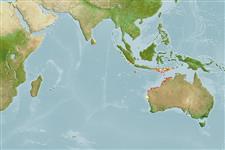Classificação / Names
Nomes comuns | Sinônimos | Catalog of Fishes(Gênero, Espécies) | ITIS | CoL | WoRMS | Cloffa
>
Gobiiformes (Gobies) >
Gobiidae (Gobies) > Gobionellinae
Etymology: Gnatholepis: Greek, gnathos = jaw + Greek,lepis = scale (Ref. 45335); argus: Named after the Greek god Argus (of the many watchful eyes), in reference to the eye-like bluespotted pattern along the side of the body in males; noun in apposition..
More on authors: Larson & Buckle.
Environment: milieu / climate zone / depth range / distribution range
Ecologia
marinhas associadas(os) a recifes; intervalo de profundidade 0 - 1 m (Ref. 76838). Tropical
Distribuição
Países | Áreas da FAO | Ecossistemas | Ocorrências | Point map | Introduções | Faunafri
Eastern Indian Ocean: Australia.
Tamanho / Peso / Idade
Maturity: Lm ? range ? - ? cm
Max length : 3.0 cm SL macho/indeterminado; (Ref. 76838); 3.3 cm SL (female)
Descrição suscinta
Morfologia | Morfometria
Espinhos dorsais (total): 6 - 7; Raios dorsais (total): 9-11; Espinhos anais 1; Raios anais : 11; Vértebras: 26. Distinguished by the following characteristics: lacking scales on side of head, predorsal midline and pectoral fin base, no distinct flap on end of lower lip (low fold may be present), and no distinct canine or enlarged teeth; sexually dimorphic in adult size and colour, with females averaging larger than males; sexually dichromatic: males with row of six dusky to blackish spots or blotches along mid-side of body, posteriormost 3-4 blackish spots darker and larger than anterior spots and surrounded by small iridescent blue spots in life, small dense black spots scattered on unpaired fins; females with broken grey line along midside of body and dusky to blackish spots or blotches indistinct and posterior blotches not darker than anterior ones, no small iridescent blue spots on body; second dorsal fin rays modally I,10; anal fin rays modally I,11; pectoral rays 15-18; lateral scales 24-28; predorsal scales absent from nape midline, scales on side of head may reach from just over opercle to nearly behind eyes (Ref. 92171).
Collected from shallow intertidal pools that are not deeper than 1 m, on rocky fringing reefs where there are low corals, especially faviids and sponges; sand to muddy substrate with surrounding waters turbid (Ref. 76838).
Ciclo de vida ou comportamento de acasalamento
Maturidade | Reprodução | Desova | Ovos | Fecundidade | Larvas
Larson, H.K. and D. Buckle, 2005. A new species of the circumtropical goby genus Gnatholepis Bleeker (Teleostei: Gobiidae: Gobionellinae) from Northern Australia. The Beagle (Rec. Mus. Art Galleries N. Terr.) 21:67-72. (Ref. 76838)
Status na Lista Vermelha da UICN (Ref. 130435)
Ameaça para os humanos
Harmless
Uso pelos humanos
Mais informação
PaísesÁreas da FAOEcossistemasOcorrênciasIntroduçõesEstoquesEcologiaDietaItens alimentaresConsumo alimentarRação
Nomes comunsSinônimosMetabolismoPredadoresEcotoxicologiaReproduçãoMaturidadeDesovaAgregação de desovaFecundidadeOvosDesenvolvimento dos ovos
Idade/TamanhoCrescimentoPeso-comprimentoComprimento-comprimentoFrequências de comprimentoMorfometriaMorfologiaLarvasDinâmica larvalRecrutamentoAbundânciaBRUVS
ReferênciasAquaculturaPerfil para aquaculturaEstirpesGenéticaElectrophoresesHereditariedadeDoençasProcessamentoNutrientsConversão de massa
ColaboradoresFotosStamps, Coins Misc.SonsCiguateraVelocidadeTipo de nataçãoÁrea branquialOtólitosCérebrosVisão
Ferramentas
Relatórios especiais
Baixar XML
Fontes da internet
Estimates based on models
Preferred temperature (Ref.
123201): 18.4 - 28.6, mean 26.6 °C (based on 124 cells).
Índice de diversidade filogenética (Ref.
82804): PD
50 = 0.5010 [Uniqueness, from 0.5 = low to 2.0 = high].
Bayesian length-weight: a=0.00977 (0.00442 - 0.02163), b=3.05 (2.86 - 3.24), in cm total length, based on LWR estimates for this (Sub)family-body shape (Ref.
93245).
Nível Trófico (Ref.
69278): 3.2 ±0.4 se; based on size and trophs of closest relatives
Resiliência (Ref.
120179): Elevada, tempo mínimo de duplicação da população menor que 15 meses (Preliminary K or Fecundity.).
Fishing Vulnerability (Ref.
59153): Low vulnerability (10 of 100).
Nutrients (Ref.
124155): Calcium = 375 [170, 1,092] mg/100g; Iron = 1.53 [0.67, 3.33] mg/100g; Protein = 18 [16, 20] %; Omega3 = 0.11 [0.04, 0.29] g/100g; Selenium = 13.1 [5.0, 35.2] μg/100g; VitaminA = 139 [26, 662] μg/100g; Zinc = 4.66 [2.58, 7.79] mg/100g (wet weight);
